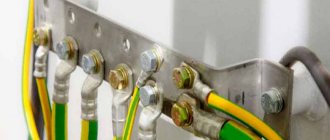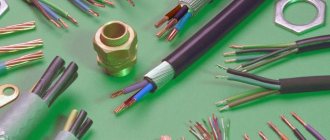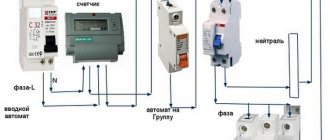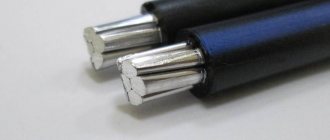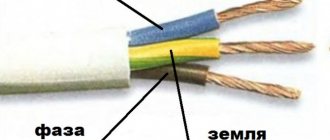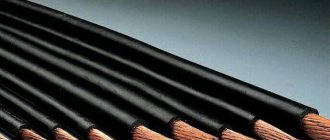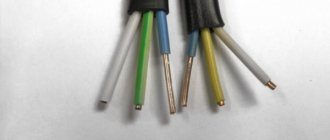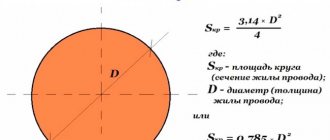Methodology for testing 0.4 kV cable lines
The essence of the test is to measure the insulation resistance and test it using increased voltage. The first process is carried out using a megger for 1 minute, and each core can be tested individually or in groups of them. The readings obtained must comply with established standards, but it is important to take into account that the insulation resistance significantly depends on the condition of the end connections and the length of the cable, therefore such a check allows you to determine only grossly developed defects and errors made during repairs.
Interpretation of wires used for overhead power lines
- SIP is a self-supporting insulated wire insulated with cross-linked polyethylene, resistant to light.
- SIP-1 – with uninsulated neutral.
- SIP-2 – with insulated neutral.
- SIP-4 - the cores have the same cross-section.
- A – uninsulated, consisting of twisted aluminum wires.
- AC is a bare wire consisting of a steel core and aluminum wires.
Test results
Testing of a 0.4 kV cable line is carried out in accordance with current rules and regulations. Testing is carried out:
- after installation or re-cabling before activating the equipment;
- after repairs have been completed.
Note that testing a 0.4 kV cable line takes from 1 to 15 minutes. The duration depends on the type of insulation used on the wires, as well as the type of testing. So, before connecting equipment after installation or relaying for cables with paper or plastic insulation, manipulation is performed for 1-10 minutes. After repair, the time increases to 15 minutes. For rubber-insulated wires, the test is carried out for 5 minutes, regardless of its type.
The permissible leakage current value for the corresponding cables is up to 0.2 mA. If the indicator is different, the equipment cannot be used.
Immediately after testing, a Protocol is drawn up. Based on this, an application for cable connection is submitted. The validity period of the Protocol is 3 days. If you do not apply for connection within 72 hours, testing will have to be repeated.
Frequency of testing cable lines
Tests are carried out immediately after laying cables, after their relocation and repair work. Their frequency is determined by established standards and requirements, which must be carefully adhered to in order to avoid emergencies and various breakdowns. For balance holders, that is, network organizations, periodic inspections are not regulated, so it is necessary to be guided by the standards for electrical installations up to 1000 V for buildings and structures. The frequency is once every 1-2 years. If you would like to receive more detailed information regarding events, our managers will advise you in detail at the most convenient time.
Marking of cables and wires
At first glance, the decoding (marking) of cable and wire designations resembles a secret code that cannot be deciphered.
In fact, each symbol carries information, knowing which you can easily understand what type of cable is in front of you and what its main characteristics are. The letters indicate the insulation and core material, the area of application of the wire, and design features. They go strictly one after another.
The numbers indicate the number of cores and their cross-section. The letter code consists of four basic symbols that you need to know. Sometimes there are more than four letters, but these are usually quite specific types of products that you are unlikely to encounter. The first letter indicates the material from which the core is made. A - aluminum; if it is copper, then there is no letter. For example, VVG and AVVG. The first cable is copper, the second is aluminum. The second letter is the area of application of the wire: K - control, M - installation, P (U) or Ш - installation, MG - flexible installation cable. If there is no letter, then it is a power wire. The third letter is the type of insulation TPG. There are many designations here: B or BP - polyvinyl chloride, D - double winding, K - nylon, P - polyethylene, P - rubber, HP or N - non-flammable rubber, C - fiberglass, W - polyamide silk, E - shielded. The fourth letter indicates the design features of the cable: B - armored with tapes, G - flexible, T - for installation in pipes, K - armored with round wire, O - braided. In addition to these designations, there are additional ones that are not written in capital letters, but in capital letters and are placed after all the others. For example, VVGng is non-flammable VVG, VVGz is filled with VVG. With numbers, everything is much simpler: the first indicates the number of cores, the second the cross-section of the core. For example, PVA 3×6 means that the wire has three cores, the cross-sectional area of each of which is 6 mm2. However, sometimes there are cables with more complex digital markings, for example, power cable KG 3×6+1×4. This means that in addition to three main conductors with a cross-section of 6 mm2, it has another smaller cross-section - 4 mm2, which serves for grounding. Foreign-made cables have a completely different type of marking, unlike GOST standards. Explanation (marking) of abbreviations used to designate power cables with PVC (vinyl) and rubber insulation (according to GOST 16442-80, TU16.71-277-98, TU 16.K71-335-2004)
A - (first letter) aluminum conductor, if there is no letter - copper conductor. AC - Aluminum core and lead sheath. AA - Aluminum core and aluminum sheath. B - Armor made of two steel strips with anti-corrosion coating. Bn - The same, but with a non-flammable protective layer (non-flammable). b – Without a pillow. B - (first (in the absence of A) letter) PVC insulation. B - (second (in the absence of A) letter) PVC sheath. D - At the beginning of the designation, this is a cable for mining, at the end of the designation, there is no protective layer over the armor or sheath (“bare”). d — Waterproof tapes for sealing the metal screen (at the end of the designation). 2g - Aluminum polymer tape over a sealed screen. Shv - Protective layer in the form of an extruded PVC hose (sheath). Shp - Protective layer in the form of an extruded hose (shell) made of polyethylene. Shps – Protective layer made from an extruded hose made of self-extinguishing polyethylene. K - Armor made of round galvanized steel wires, on top of which a protective layer is applied. If it appears at the beginning of the designation, it means a control cable. C – Lead sheath. O - Separate shells on top of each phase. R – Rubber insulation. NR - Rubber insulation and sheath made of flame retardant rubber. P - Insulation or shell made of thermoplastic polyethylene. Ps - Insulation or shell made of self-extinguishing, non-flammable polyethylene. Pv - Insulation made of vulcanized polyethylene. BBG - Armor of profiled steel tape. ng - Non-flammable. LS - Low Smoke - low smoke and gas emissions. KG - Flexible cable.
Cable with BPI - impregnated paper insulation (according to GOST 18410-73): A - (first letter) aluminum core, in its absence - copper core by default. If in the middle of the designation after the symbol of the core material, then the aluminum sheath. B – Armor made of flat steel strips (after the shell material symbol). AB - Aluminum armor. SB - (first or second (after A) letter) lead armor. C – Shell material is lead. O - Separately leaded conductor. P - Armor made of flat galvanized steel wires. K - Armor made of round galvanized steel wires. B – Paper insulation with depleted impregnation (at the end of the designation) through a dash. b – Without a pillow. l — The pillow contains an additional 1 Mylar ribbon. 2l — The pillow contains an additional double lavsan ribbon. D - Lack of a protective layer (“bare”). n – Non-flammable outer layer. Placed after the armor symbol. Shv - The outer layer in the form of an extruded hose (shell) made of polyvinyl chloride. Шп – Outer layer in the form of a pressed hose (shell) made of polyethylene. Shvpg - The outer layer is made of a pressed hose made of low-flammability polyvinyl chloride. (ozh) – Cables with single-wire conductors (at the end of the designation). U - Paper insulation with increased heating temperature (at the end of the designation). C – Paper insulation impregnated with a non-drip compound. Placed in front of the designation.
Control cable (according to GOST 1508-78): A - (first letter) aluminum core, in its absence - copper core by default. B - (second (in the absence of A) letter) PVC insulation. B - (third (in the absence of A) letter) PVC sheath. P - Polyethylene insulation. Ps - Insulation made of self-extinguishing polyethylene. D - Lack of a protective layer (“bare”). R - Rubber insulation. K - (first or second (after A) letter) - control cable. In addition to KG, the cable is flexible. F – PTFE insulation. E - At the beginning of the designation - a power cable for special mine conditions, in the middle or at the end of the designation - a shielded cable.
Suspended wires: A - Aluminum bare wire. AC - Aluminum-Steel (the word “steel-aluminum” is more often used) bare wire. SIP - Self-supporting Insulated Wire. ng - Non-flammable.
Power, installation wires and connecting cords:
A - Aluminum, the absence of the letter A in the wire brand means that the current-carrying conductor is made of copper. P (or Ш) – the second letter, denotes a wire (or cord). R - Rubber insulation. B – PVC insulation. P – Polyethylene insulation. N – Nairite rubber insulation. The number of cores and cross-section are indicated as follows: put a dash; record the number of cores; put a multiplication sign; record the cross-section of the core. Brands of wires and cords may contain other letters that characterize other structural elements: D - Double wire. O - Braid. T - For installation in pipes. P - Flat with a dividing base. G - Flexible.
Mounting wires:
M – Installation wire (placed at the beginning of the designation). G - Multi-wire conductor (the absence of a letter indicates that the conductor is single-wire). Ш - Polyamide silk insulation. C — Film insulation. B - Polyvinyl chloride insulation. K - Nylon insulation. L – Lacquered. C - Fiberglass winding and braiding. D - Double braid. O - Polyamide silk braid. E – Shielded. ME - Enameled.
Explanation (labeling) of some special abbreviations:
KSPV - Cables for Transmission Systems in Vinyl sheath. KPSVV - Fire Alarm Cables, with Vinyl insulation, Vinyl sheathed. KPSVEV - Fire Alarm Cables, with Vinyl insulation, with Screen, in Vinyl sheath. PNSV - Heating wire, Steel core, Vinyl sheath. PV-1, PV-3 - Wire with Vinyl insulation. 1, 3 - core flexibility class. PVS - Wire in Vinyl Sheath Connecting. SHVVP - Cord with Vinyl insulation, Vinyl sheathed, Flat. PUNP - Universal Flat Wire. PUGNP - Universal Flat Flexible Wire.
Explanation (labeling) Cables and wires of foreign production
Power cable: N - Indicates that the cable is manufactured according to the German VDE standard (Verband Deutscher Elektrotechniker - Union of German Electrical Engineers). Y – PVC insulation. H - Absence of halogens (harmful organic compounds) in PVC insulation. M - Installation cable. C – Availability of copper screen. RG – Availability of armor.
FROR is an Italian-made cable, has specific designations according to the Italian standard CEI UNEL 35011:
F - corda flessibile - flexible core. R - polivinilclorudo - PVC - PVC insulation O - anime riunite per cavo rotondo - round, not flat cable. R - polivinilclorudo - PVC - PVC shell.
Control cable: Y – PVC insulation. SL - Control cable. Li - Stranded conductor made according to the German VDE standard (see above).
Halogen-free fire-resistant cable: N - Manufactured according to the German VDE standard (see above). HX – Cross-linked rubber insulation. C - Copper screen. FE 180 - In case of fire, the integrity of the insulation, when using a cable without a fastening system, is maintained for 180 minutes. E 90 - In the event of a fire, the cable's operability when laid together with the fastening system is maintained for 90 minutes.
Mounting Wires: H - Harmonized Wire (HAR Approved). N - Compliance with national standard. 05 - Rated voltage 300/500 V. 07 - Rated voltage 450/750 V. V - PVC insulation. K – Flexible core for stationary installation.
Cables with XLPE insulation: N – Manufactured according to the German VDE standard (see above). Y – PVC insulation. 2Y – Polyethylene insulation. 2X – XLPE insulation. S - Copper screen. (F) - Longitudinal sealing. (FL) - Longitudinal and transverse sealing. E - Three-core cable. R - Armor made of round steel wires.
Prices for services
| № | Name of tests | Units | Cost of work per unit of equipment, including VAT |
| 1 | Measuring the impedance of the phase-zero circuit | 1 chain | 180,00 |
| 2 | Insulation resistance measurement | ||
| 2.1. | Cable 1ph. lines | 1 line | 190,00 |
| 2.2. | Cable 3ph. lines | 1 line | 190,00 |
| 2.3. | Prefabricated and connecting busbars up to 1 kV | 1 dimension | 190,00 |
| 2.4. | Winding of machines and devices | 1 device | 480,00 |
Examples of decoding control cable brands
- KSBG -4x1.5+1x1.0 – control cable in a lead sheath, armored, anti-corrosion coating, has four cores with a cross-section of 1.5 square millimeters and one of 1 square millimeter. mm.
- AKVVG is a control cable with aluminum conductors in polyvinyl chloride insulation in a PVC sheath, with an anti-corrosion coating.
- KVBBShVng-LS 4x2.5 control cable with copper cores, four cores with a cross-section of 2.5 square millimeters, is intended for fixed connection to electrical devices with voltages up to 660 Volts.
Examples of decoding foreign-made cables
NYM - power cable with copper cores, insulated cores of multi-core cables are twisted in PVC insulation, belt insulation made of unvulcanized rubber compound (single-core cables without belt insulation), gray PVC sheath.
Theoretically, the brand of cable, wire or cord, if you look at the table, includes seven to eight letters, not counting the numbers. But in reality, when designating brands of cable products, fewer letters are used. This is explained by the fact that some letters are not included, for example, in the designation of a copper core, the absence of armor or protective cover.
For detailed information about cable and wire products, please call 204-52-86, 204-52-91
